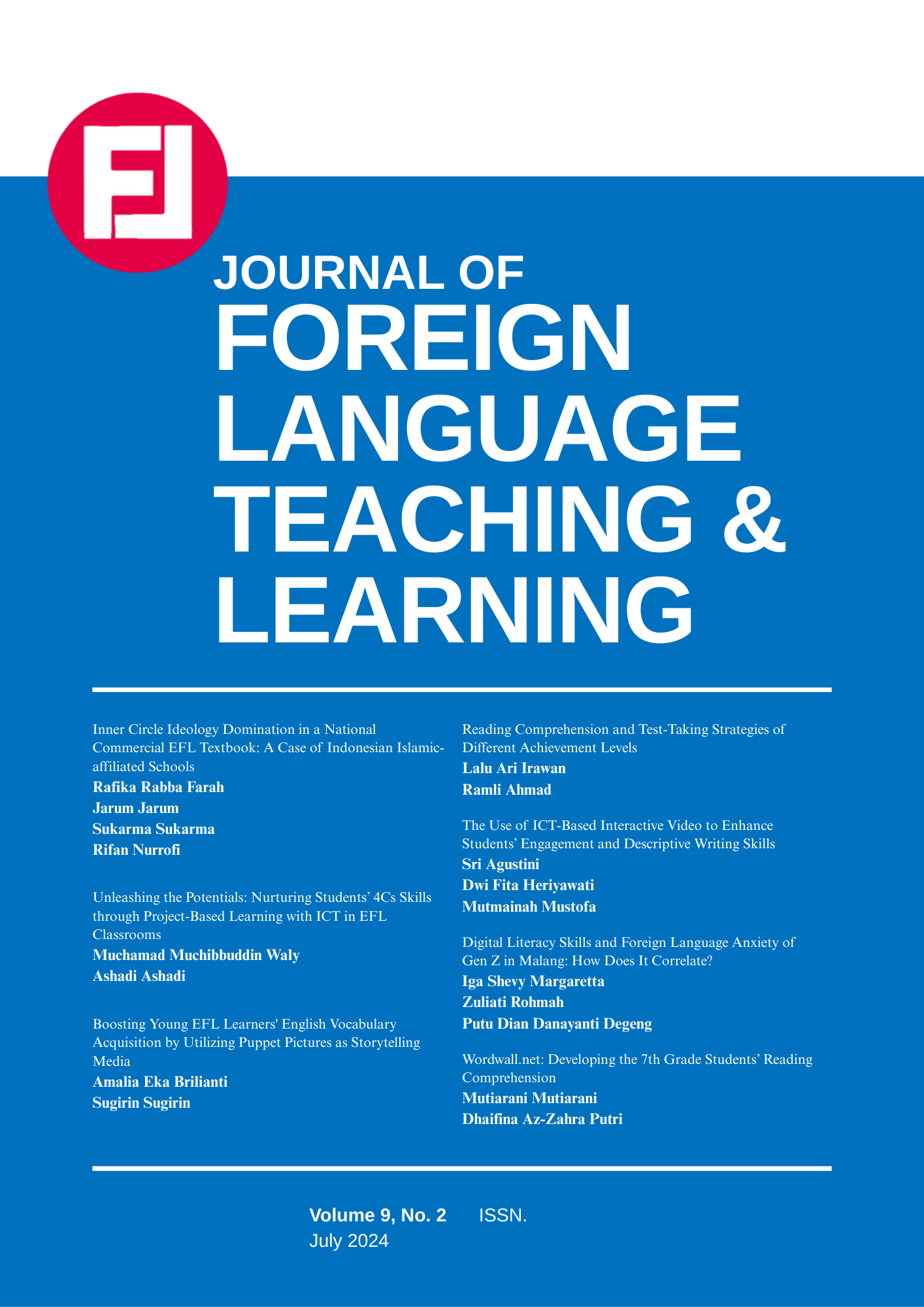Inner Circle Ideology Domination in a National Commercial EFL Textbook: A Case of Indonesian Islamic-affiliated Schools
DOI:
https://doi.org/10.18196/ftl.v9i2.20663Keywords:
Critical discourse analysis, English textbook, Islamic-affiliated schoolAbstract
This study employs an analysis of visual images in English textbooks used in Islamic-affiliated schools through the lens of Kachru’s three-circle model of English, which categorizes English-speaking countries into Inner, Outer, and Expanding circles. This study aims to explore how these images reflect and reinforce linguistic and cultural ideologies associated with each circle. A qualitative content analysis was implemented, focusing on the visual images within English textbooks, which were categorized based on the representation of cultural elements. Data analysis was implemented using a coding scheme and Critical Discourse Analysis framework, examining the power relations and ideological influences represented by the visual content of the textbook. Results show that inner circle culture was dominantly represented (67.9%) in the textbook of its visual use. Western-looking people, outfits, movies, and food represent the images used in the textbook. The finding suggests that textbooks used in English teaching at Islamic affiliated schools, or madrasas, must be carefully designed and selected to adjust students’ needs and school context, as teaching a foreign language can carry others’ ideologies and power.
References
Afriana, S., & Rokhimawan, M. A. (2022). Innovation of basic education curriculum to optimize learners spiritual character. Qalamuna: Jurnal Pendidikan, Sosial, dan Agama, 14(1), 195–206. https://doi.org/10.37680/qalamuna.v14i1.1479
Afzal, T., Chishti, M. I., Jadoon, A. U. R., & Mushtaq, H. (2021). A comparative analysis of ideological constructions embedded in English textbooks: A critical discourse perspective. Humanities & Social Sciences Reviews, 9(2), 487-498. https://doi.org/10.18510/hssr.2021.9247
Agustina, Y., Widodo, P., & Margana, M. (2024). Creating an Islamic boarding school English corpus: Corpus metadata, frequently used words, and unique words. Journal of Education and Learning (EduLearn), 18(3), 804-816. https://doi.org/10.11591/edulearn.v18i3.21095
Ahmadi, A., & Derakhshan, A. (2015). An evaluation of the Iranian junior high school English textbooks. International Journal of English Language and Literature Studies, 4(1), 37-48. https://doi.org/10.18488/journal.23/2015.4.1/23.1.37.48
Alfian, A., Yusuf, M., & Nafiah, U. (2022). Integrating Islamic values in teaching English: Lessons learned from an integrated Islamic school. Elsya : Journal of English Language Studies, 4(1), 1–11. https://doi.org/10.31849/elsya.v4i1.7322
Apple, M. W. (Ed.). (2012). Knowledge, power, and education: The selected works of Michael W. Apple. Routledge. https://doi.org/10.4324/9780203118115
Arslan, S. (2016). An analysis of two Turkish EFL books in terms of cultural aspects. Procedia-Social and Behavioral Sciences, 232, 217-225. https://doi.org/10.1016/j.sbspro.2016.10.049
Bahrami, N. (2015). Evaluating the representation of cultural elements in an in-use EFL textbook. Advances in Language and Literary Studies, 6(3), 128–137. http://dx.doi.org/10.7575/aiac.alls.v.6n.3p.128
Cahyo, S. D., Muslim, M. R. U., Rahman, A. N., & Pratolo, B. W. (2019). Needs analysis of Islamic-based English reading material for the Muhammadiyah junior high school. International Journal of Evaluation and Research in Education (IJERE), 8(2), 286-292. https://doi.org/10.11591/ijere.v8i2.18647
Camase, G. (2009). The ideological construction of a second reality: A critical analysis of a Romanian EFL textbook [Thesis. University of Toronto]. TSpace. https://hdl.handle.net/1807/18099
Chao, T. (2011). The hidden curriculum of cultural content in internationally published ELT textbooks: A closer look at new american inside out. The Journal of Asia TEFL, 8(2),189-210. http://journal.asiatefl.org/main/main.php?inx_journals=28&inx_contents
Curaming, E. M., & Curaming, R. A. (2020). Gender (in)equality in English textbooks in the Philippines: A critical discourse analysis. Sexuality & Culture, 24(4), 1167–1188. https://doi.org/10.1007/s12119-020-09750-4
Damayanti, I. L. (2014). Gender construction in visual images in textbooks for primary school students. Indonesian Journal of Applied Linguistics, 3(2), 100-116. https://doi.org/10.17509/ijal.v3i2.272
Dar, S., & Masroor, F. (2019). Cultural dissemination: A case study of English textbooks at primary level in Pakistan. International Journal of Innovation in Teaching and Learning (IJITL), 5(2), 33-48 https://doi.org/10.35993/ijitl.v5i2.699
Derakhshan, A. (2024). ‘Should textbook images be merely decorative?’: Cultural representations in the Iranian EFL national textbook from the semiotic approach perspective. Language Teaching Research, 28(1), 79–113. https://doi.org/10.1177/1362168821992264
Djamdjuri, D. S., Gatot, M., Yusiyaka, R. A., Sahril, M., Mufaridah, F., & Pratama, M. I. (2023). Systematic literature review: Integrating Islamic education in English language teaching. Journal of English Education and Teaching, 7(4), 881-900. https://doi.org/10.33369/jeet.7.4.881-900
Ekowati, D. M., Noni, N., & Atmowardoyo, H. (2021). An analysis on gender representation in cambridge checkpoint English coursebook. Celebes Journal of Language Studies, 88–101. https://doi.org/10.51629/cjls.v1i1.40
Emaliana, I., & Tusita, A. (2019). Exploring gender representation: patriarchal perspectives from efl secondary school textbooks in Indonesia. International Journal of Research -GRANTHAALAYAH, 7(11), 146-153. https://doi.org/10.29121/granthaalayah.v7.i11.2020.345
Farah, R. R. (2020). Infusing Islamic-related content through trivia cards: Research & development in ESP classroom. EduLite: Journal of English Education, Literature and Culture, 5(1), 78-88. https://doi.org/10.30659/e.5.1.78-88
Farah, R. R., Waloyo, A. A., & Sumarsono, P. (2021). Incorporating English and Islamic knowledge into workbook development for primary school students. IJOTL-TL: Indonesian Journal of Language Teaching and Linguistics, 6(2), 189-202. https://doi.org/10.30957/ijoltl.v6i2.673
Fauzi, A., & Dewi, T. A. K. (2024). Cultural representation on the functional grammar exercises in an Indonesian junior high school English textbook. Journal of English Education Program, 5(1). 95-106. https://doi.org/10.26418/jeep.v5i1.71519
Fenyi, K., & Sapaty, G. A. (2021). Ideological underpinnings in president John Dramani Mahama’s 2013 state of the nation address: a critical discourse analysis. Linguistics Initiative, 1(1), 1-17. https://doi.org/10.53696/27753719.17
Irwansyah, D. (2018). Teaching English at Indonesian Islamic higher education: An epistemological perspective. Dinamika Ilmu, 18(1), 1-13. https://doi.org/10.21093/di.v18i1.1120
Iswan, I., & Zaitun, Z. (2020). Integrating Islamic values on ESL classes: Indonesian teachers’ attitudes toward Islamic education management in South Thailand. Ta’dib: Jurnal Pendidikan Islam, 25(2), 96-106. https://doi.org/10.19109/td.v25i2.6201
Kasmawati, K., Herlian, H., Adam, A., Deluma, R., Abubakar, A., & Muliyani, M. (2023). Transformation of Islamic Education: Fostering exemplary character through integrated curriculum in Islamic elementary schools. Journal of Leadership, Management, and Policy in Education, 1(2), 33-40. https://doi.org/10.51454/jlmpedu.v1i2.427
Khan, M. A., & Zaki, S. (2022). Corpus assisted critical discourse analysis of Pakistan’s language education policy documents: What are the existing language ideologies? Sage Open, 12(3), 1-19. https://doi.org/10.1177/21582440221121805
Khan, M. Y., & Ali, A. (2022). Exploring ideologies in primary english textbook (SNC-2020): A critical discourse analysis. Perennial Journal of History, 3(1), 35-48. https://doi.org/10.52700/pjh.v3i1.99
Kim, S.-H., & Lee, H. (2023). Asserting Koreanness in South Korean middle school English textbooks. World Englishes, 42(3), 544–561. https://doi.org/10.1111/weng.12548
Kirana, S. N., & Methitham, P. (2022). Native-speakerism in a locally developed Indonesian EFL textbook: A critical discourse study. Journal of English and Education (JEE), 1–15. https://doi.org/10.20885/jee.v8i1.23063
Kusramadhani, S., Nirwanto, R., & Widiastuty, H. (2022). Moral values in English textbook: "When English rings a bell". PROJECT (Professional Journal of English Education), 5(2), 344–353. https://doi.org/10.22460/project.v5i2.p344-353
Lasmita, R., Arsyad, S., & Harahap, A. (2024). Cultural content analysis of English textbooks for junior high school entitled “Bahasa Inggris when english rings a bell.” Journal of English for Specific Purposes in Indonesia, 3(1), 64-73. https://doi.org/10.33369/espindonesia.v3i1.25902
Liannita, D., Aridah, A., & Bonganciso, R. T. (2023). Gender representation on visual illustrations in Indonesia EFL textbook. Journal of English as A Foreign Language Teaching and Research, 3(2), 59-70. https://doi.org/10.31098/jefltr.v3i2.1776
Liu, H. (2020). Ideologies in college EFL textbooks–A content analysis based on critical pedagogy. Journal of Language Teaching and Research, 11, 937-942,. https://doi.org/10.17507/jltr.1106.09
Madkur, A., & Albantani, A. M. (2017). Instilling Islamic Values in Foreign Language Teaching: An Indonesian Context. 97–103. https://doi.org/10.2991/icems-17.2018.20
Maesaroh, D. T., Aridah, A., & Rusmawaty, D. (2022). Can Islamic stories be used as supplementary English materials at Islamic elementary schools? Southeast Asian Journal of Islamic Education, 4(2), 145-156. https://doi.org/10.21093/sajie.v4i2.4166
Maesaroh, D. T., Asih, Y. U., & Suhatmady, B. (2022). Does the English textbook for young learners in Indonesia promote gender equality? IJELTAL (Indonesian Journal of English Language Teaching and Applied Linguistics), 7(1), 35-50. https://doi.org/10.21093/ijeltal.v7i1.1152
Mahrudin, M. A. S., Hidayat, D. N., Husna, N., & Alek, A. (2023). Critical discourse analysis of moral values in EFL textbook for senior high school. Al-Lisan: Jurnal Bahasa (e-Journal), 8(1), 45-61. https://doi.org/10.30603/al.v8i1.3287
Muslim, B. Z., Putri, D. N., Rizqoh, S. A., & Basya, D. (2022). The representation of Islamic value in government-mandated English language textbook: A critical discourse analysis. Rainbow : Journal of Literature, Linguistics and Culture Studies, 11(2), 22-34. https://doi.org/10.15294/rainbow.v11i2.58399
Nizar, R. I. (2024). An analysis of cultural stereotypes in an Indonesian government-endorsed EFL textbook [Thesis, Universitas Islam Indonesia]. https://dspace.uii.ac.id/handle/123456789/49904
Nurkamto, J., Drajati, N. A., Ngadiso, N., & Karlina, Y. (2021). Teachers’ beliefs and practices in teaching reading at Islamic secondary schools in Indonesia. Indonesian Journal of Applied Linguistics, 10(3), 667-676. https://doi.org/10.17509/ijal.v10i3.31753
Parlindungan, F., Rifai, I., & Safriani, A. (2018). The representation of Indonesian cultural diversity in middle school English textbooks. Indonesian Journal of Applied Linguistics, 8(2). 289-302. https://doi.org/10.17509/ijal.v8i2.13276
Pennycook, A. (2006). Global Englishes and Transcultural Flows. Global Englishes and Transcultural Flows, 1–189. https://doi.org/10.4324/9780203088807
Pennycook, A. (2017). The Cultural Politics of English as an International Language. In The Cultural Politics of English as an International Language (p. 365). https://doi.org/10.4324/9781315225593
Phillipson, R. (2012). Linguistic Imperialism. In The Encyclopedia of Applied Linguistics. John Wiley & Sons, Ltd. https://doi.org/10.1002/9781405198431.wbeal0718
Prastikawati, E. F., & Yonata, F. (2022). Female representation in primary school english textbooks: the portrait of gender in indonesian EFL education. KnE Social Sciences, 988–1004. https://doi.org/10.18502/kss.v7i14.12049
Qoriah, M. (2020). An analysis of visual social semiotics in English textbook. Edukasi: Jurnal Pendidikan Dan Pengajaran, 6–18. https://doi.org/10.19109/ejpp.v6i2.5518
Ramadhani, Z., & Refnaldi, R. (2024). Cultural sense analysis of reading text for the seventh grade in the junior high school English textbook: “English for Nusantara.” Journal of Languages and Language Teaching, 12(3), 1431–1442. https://doi.org/10.33394/jollt.v12i3.11380
Roohani, A., & Sharifi, M. (2015). Evaluating visual elements in two EFL textbooks. Indonesian Journal of Applied Linguistics, 4(2), 68-77. https://doi.org/10.17509/ijal.v4i2.684
Rosa, J. D. (2016). Standardization, racialization, languagelessness: Raciolinguistic ideologies across communicative contexts. Journal of Linguistic Anthropology, 26(2), 162–183. https://doi.org/10.1111/jola.12116
Safitri, C. D., Jabu, B., & Samtidar, S. (2023). The integration of Islamic values in English language teaching context: Practices and challenges. Celebes Journal of Language Studies, 315–324. https://doi.org/10.51629/cjls.v3i2.156
Setyono, B., & Widodo, H. P. (2019). The representation of multicultural values in the Indonesian Ministry of Education and Culture-Endorsed EFL textbook: A critical discourse analysis. Intercultural Education, 30(4), 383–397. https://doi.org/10.1080/14675986.2019.1548102
Sui, J. (2022). Gender role of characters in the illustrations of local and introduced edition textbooks of college portuguese teaching in China. Journal of Language Teaching and Research, 13(6), 1232-1242. https://doi.org/10.17507/jltr.1306.11
Sulistiyo, U., Wulan, R., Arif, T. Z. Z. A., Efriza, D., & Anwar, K. (2021). A critical content analysis of English textbook for senior high school students in Indonesia. Studies in English Language and Education, 8(1), 84-98. https://doi.org/10.24815/siele.v8i1.16778
Tafazoli, D., & Egan, K. (2022). Antagonism between Western and Islamic cultures in Iranian English textbooks. Porta Linguarum Revista Interuniversitaria de Didáctica de Las Lenguas Extranjeras, 37, 63-88. https://doi.org/10.30827/portalin.vi37.21243
Ulum, Ö. G., & Köksal, D. (2019). Ideological and hegemonic practices in global and local EFL textbooks written for Turks and Persians. Acta Educationis Generalis, 9(3), 66–88. https://doi.org/10.2478/atd-2019-0014
Ulum, Ö. G., & Köksal, D. (2021). A critical inquiry on the ideological and hegemonic practices in EFL textbooks. Multicultural Learning and Teaching, 16(1), 45–61. https://doi.org/10.1515/mlt-2019-0005
van Dijk, T.A. (2008). Discourse and Context: A Sociocognitive Approach. Cambridge University Press, New York
Wang, P. (2022). Relooking at the roles of translanguaging in English as a foreign language classes for multilingual learners: Practices and implications. Frontiers in Psychology, 13. 1-11. https://doi.org/10.3389/fpsyg.2022.850649
Widodo, H. P. (2018). A Critical micro-semiotic analysis of values depicted in the Indonesian Ministry of National Education-endorsed secondary school English textbook. In H. P. Widodo, M. R. Perfecto, L.
Van Canh, & A. Buripakdi (Eds.), Situating moral and cultural values in elt materials: The southeast asian context (pp. 131–152). Springer International Publishing. https://doi.org/10.1007/978-3-319-63677-1_8
Wilfitri, E., & Suganda, S. P. (2023). Teacher voices of gender representation in EFL textbook: A case study in a senior high school. Lingua Didaktika: Jurnal Bahasa Dan Pembelajaran Bahasa, 17(2), 157-171. https://doi.org/10.24036/ld.v17i2.126204
Wulandari, C., Hastowohadi, H., & Prasetiyo, T. H. (2024). A critical visual analysis of gender stereotyping in the indonesian secondary school english textbook. Journal of Technology, Education & Teaching (J-Tech), 1(1), 29-47. https://doi.org/10.62734/jtech.v1i1.174
Xiang, R., & Yenika-Agbaw, V. (2021). EFL textbooks, culture and power: A critical content analysis of EFL textbooks for ethnic Mongols in China. Journal of Multilingual and Multicultural Development, 42(4), 327–341. https://doi.org/10.1080/01434632.2019.1692024
Yang, Y. (2023). Ideology in critical discourse study: A review of literature. Journal of the University of Ruhuna, 11(2). 53-63 https://doi.org/10.4038/jur.v11i2.8012
Yanti, M. S., & Wirza, Y. (2022). Gender representation in the textbook for vocational school students in the Indonesian EFL settings. ELT Forum: Journal of English Language Teaching, 11(3), 217-228. https://doi.org/10.15294/elt.v11i3.58723
Yazdanmehr, E., & Shoghi, S. (2014). Design and application of a ‘textbook visual effects’ evaluation checklist. Theory and Practice in Language Studies, 4(3), 473–480. https://doi.org/10.4304/tpls.4.3.473-480
Downloads
Published
How to Cite
Issue
Section
License
Copyright
Authors retain copyright and grant the journal right of first publication with the work simultaneously licensed under a Creative Commons Attribution-ShareAlike 4.0 International License that allows others to share the work with an acknowledgment of initial publication in this journal.
Authors are permitted and encouraged to post their work online (e.g., in institutional repositories, social media account, or on their website) after the article getting published in the journal, as it can lead to productive exchanges and earlier and greater citation of published work (See The Effect of Open Access).License
You are free to:
- Share — copy and redistribute the material in any medium or format
- Adapt — remix, transform, and build upon the material for any purpose, even commercially.
Attribution — You must give appropriate credit, provide a link to the license, and indicate if changes were made. You may do so in any reasonable manner, but not in any way that suggests the licensor endorses you or your use.
ShareAlike — If you remix, transform, or build upon the material, you must distribute your contributions under the same license as the original.
- No additional restrictions — You may not apply legal terms or technological measures that legally restrict others from doing anything the license permits.



.png)





